You're using an outdated browser. Please upgrade to a modern browser for the best experience.
Please note this is a comparison between Version 2 by Camila Xu and Version 1 by Lin Zhang.
Nepalese alder (Alnus nepalensis), a plant of the alder genus Alnus in the family of Betulaceae, is described in the Flora of China as growing in river beach wetlands or gully terrace forests at a wide range of altitudes between about 700 and 3600 m. It grows fast in warm and humid environments, with a height exceeding 13 m over 5 years, and it has a strong carbon sequestration capacity.
- biological nitrogen fixation
- bibliometrics
- climate change
1. Introduction
Nepalese alder (Alnus nepalensis), a plant of the alder genus Alnus in the family of Betulaceae, is described in the Flora of China as growing in river beach wetlands or gully terrace forests (Figure 1) at a wide range of altitudes between about 700 and 3600 m. It grows fast in warm and humid environments, with a height exceeding 13 m over 5 years [1], and it has a strong carbon sequestration capacity [2]. This species is resistant to barrenness, and is often used for riverside berms and barren mountain beautification. Thus, it has been selected as an ideal tree species for ecological shelter forest and mixed afforestation [3,4][3][4]. At the same time, as a high-quality papermaking raw material, the Nepalese alder is an important tree species used to create short-cycle industrial wood raw material forests. Therefore, this species is listed in China’s “Forest Resources Development and Protection Project” (FRDPP), and it is the main broad-leaved tree species for the construction of papermaking industries [5]. The characteristics of Nepalese alder as a pioneering species, its rapid growth, and its high-quality fuel carbon are inseparable from its nitrogen fixation performance by the symbiotic nodules where the Frankia is attached [6]. This nitrogen fixation performance increases soil organic matter and nitrogen and phosphorus nutrient content [7[7][8],8], promotes soil microbial reproduction, and increases soil enzyme activity [9]. To some extent, the improvement of soil properties also promotes the growth and development of other plants within the same area, so Nepalese alder is often introduced into agroforestry to enhance the biological production of target species. In the eastern Himalayas, agroforestry ecosystems dominated by cardamom (Amomum subulatum) and Nepalese alder are specially created [10], and Sharma et al. (2002b) found that the energy conversion efficiency and net energy increase of alder–cardamom were significantly higher than those of an ordinary cardamom system, and the production potential of the ecosystem was also optimized [11]. In addition, studies have pointed out that the new branches and leaves of Nepalese alder reflected high moisture content and are not prone to canopy fires. Therefore, it can be cultivated in large quantities as a biological fireproof tree species [12]. In all, the Nepalese alder plays an important role in maintaining the stability of forest ecosystems, agroforestry ecosystems, and the sustainable development of forestry.
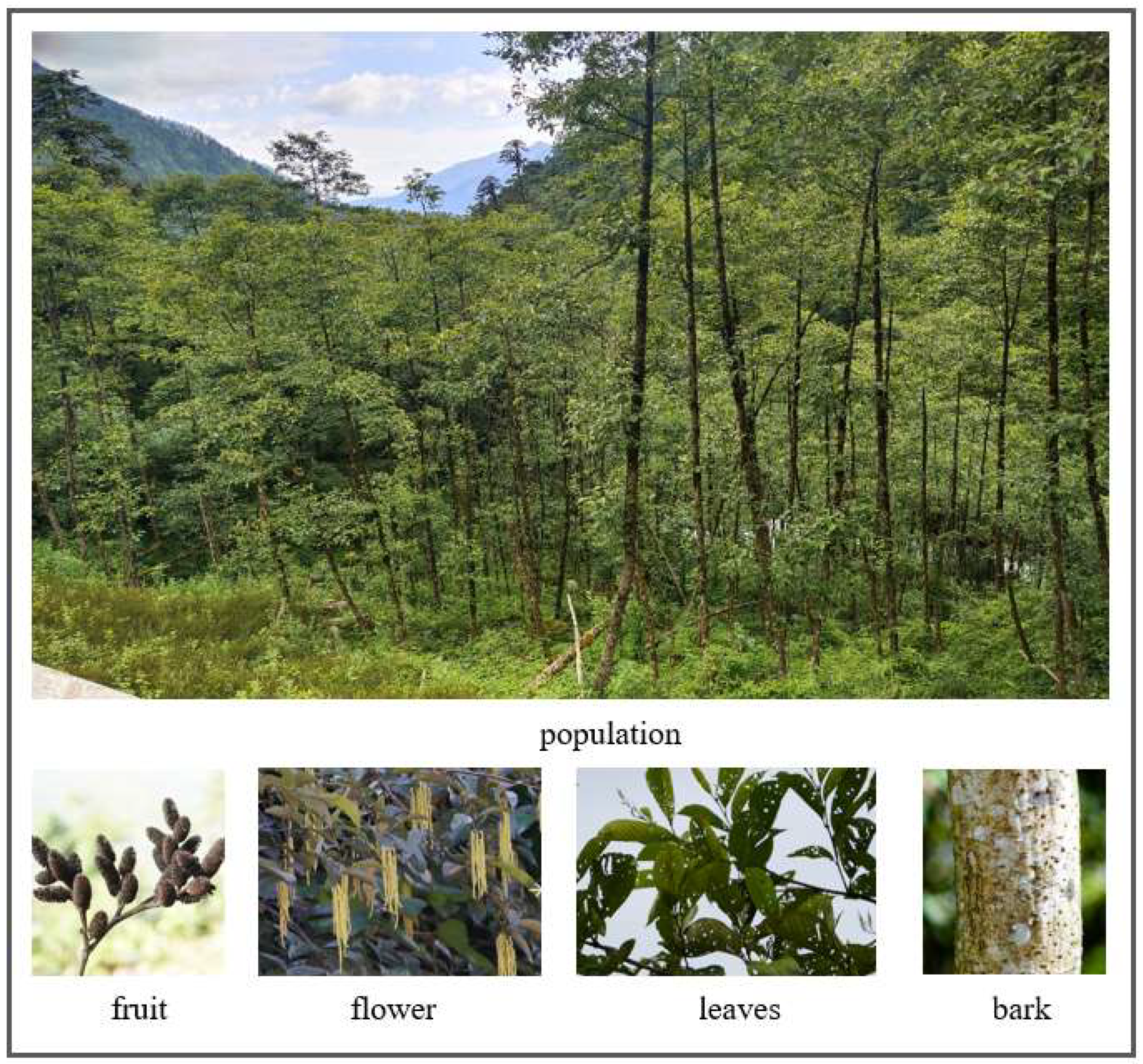
Figure 1.
Community structure and organ characters of Nepalese alder (Motuo, Tibet).
According to the Flora of China, the distribution of Nepalese alder spans a large altitudinal gradient near 3000 m, which indicates that this species is well-adapted to different environments. In addition, the clear altitude limit (especially the upper limit) indicates that there is an obvious hydrothermal constraint. However, at present, research on the correlation between alder and environmental factors mainly focused on the effects of nitrogen- and phosphorus-addition treatments on the growth of alder seedlings in Nepal [13[13][14],14], whereas research concentrating on the relationships between alder and hydrothermal factors such as temperature and precipitation is still lacking on a large scale [15]. In addition, Frankia attached to the roots of Nepalese alder are closely related to the nitrogen fixation ability of the tree itself, and as an actinomycete in microorganisms, its activity is also affected by environmental factors [16]. Thus, the response of Frankia to environmental factors will also affect the growth of Nepalese alder.
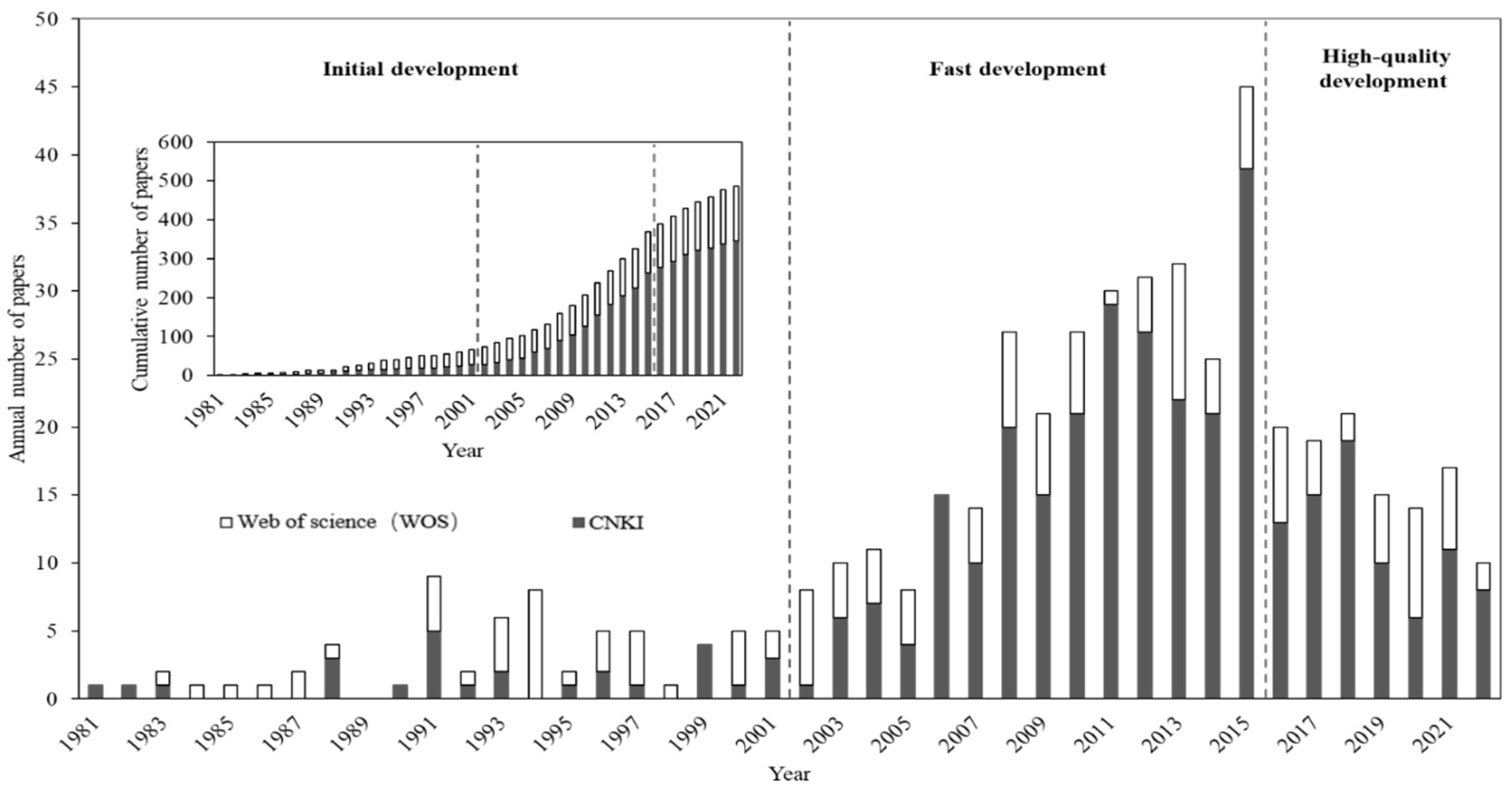
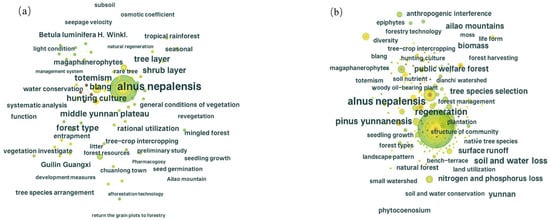
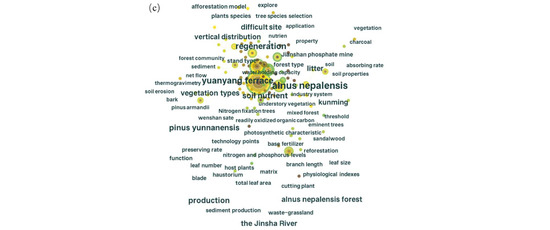
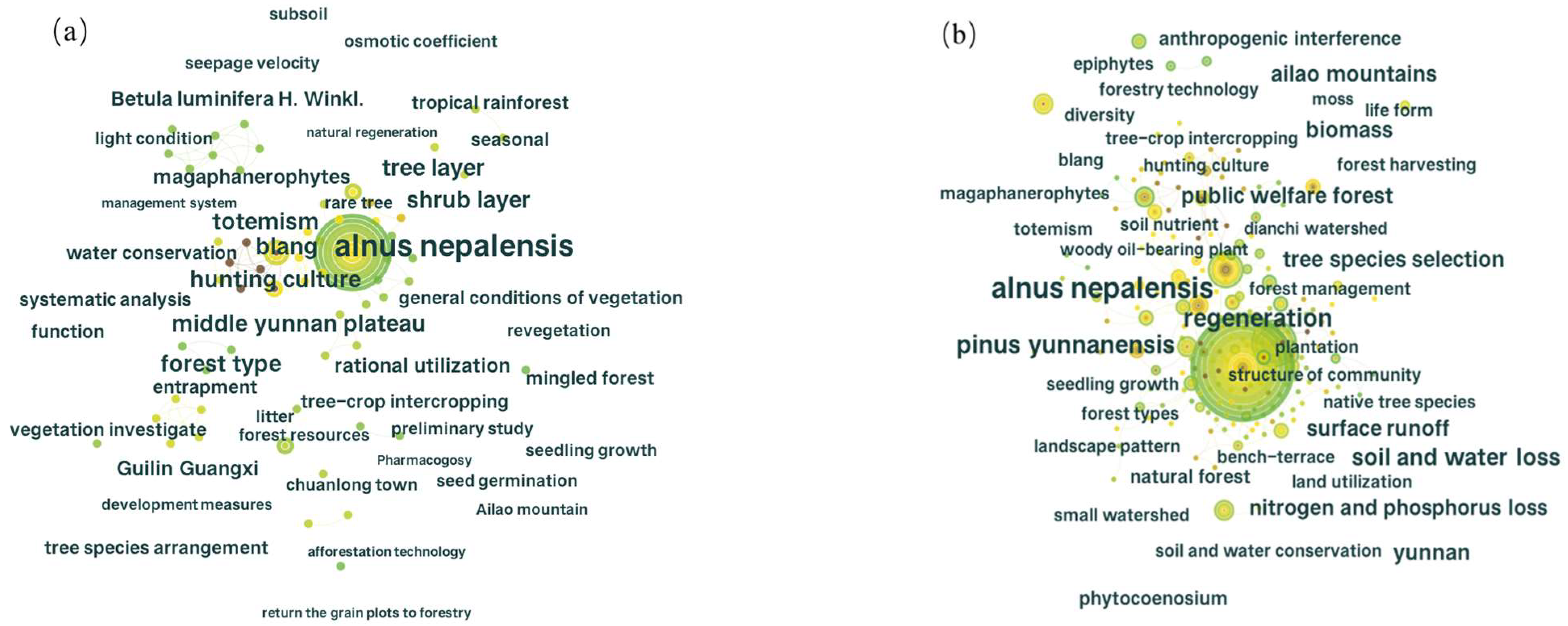
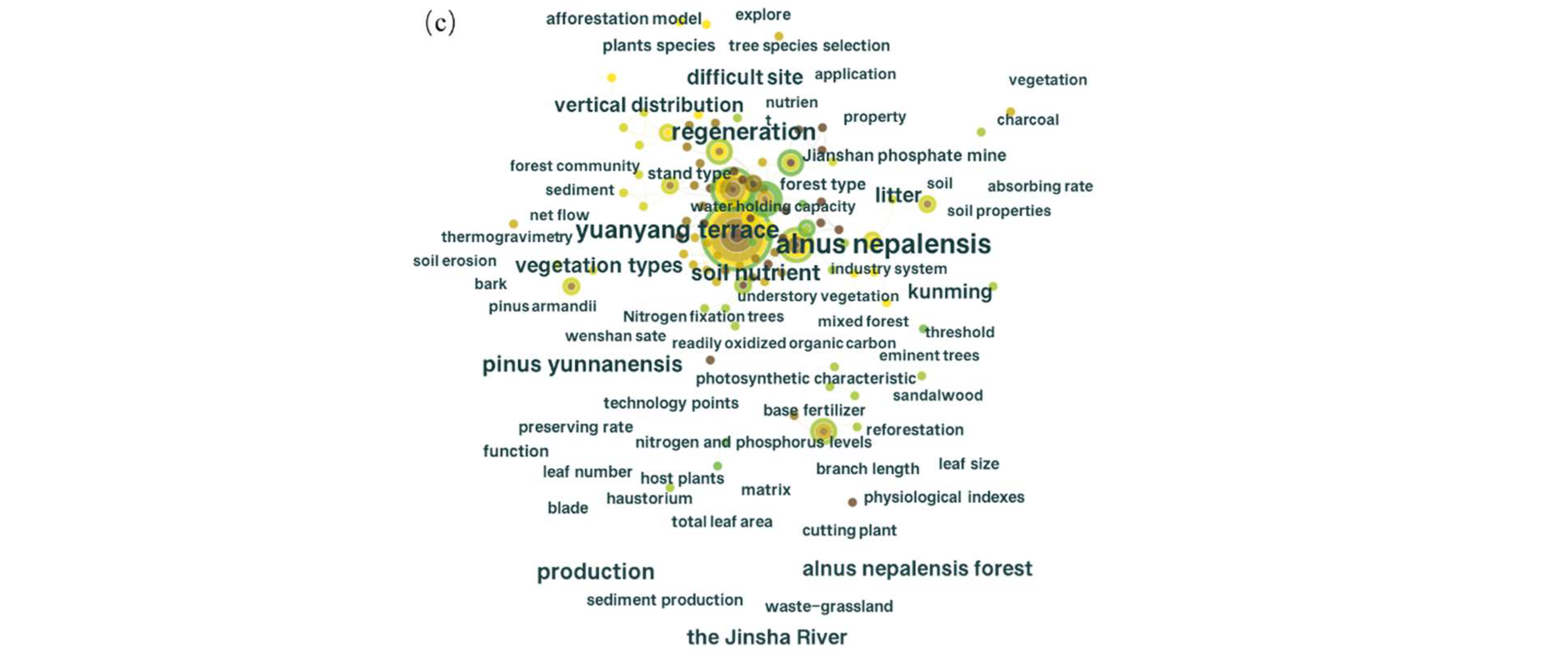
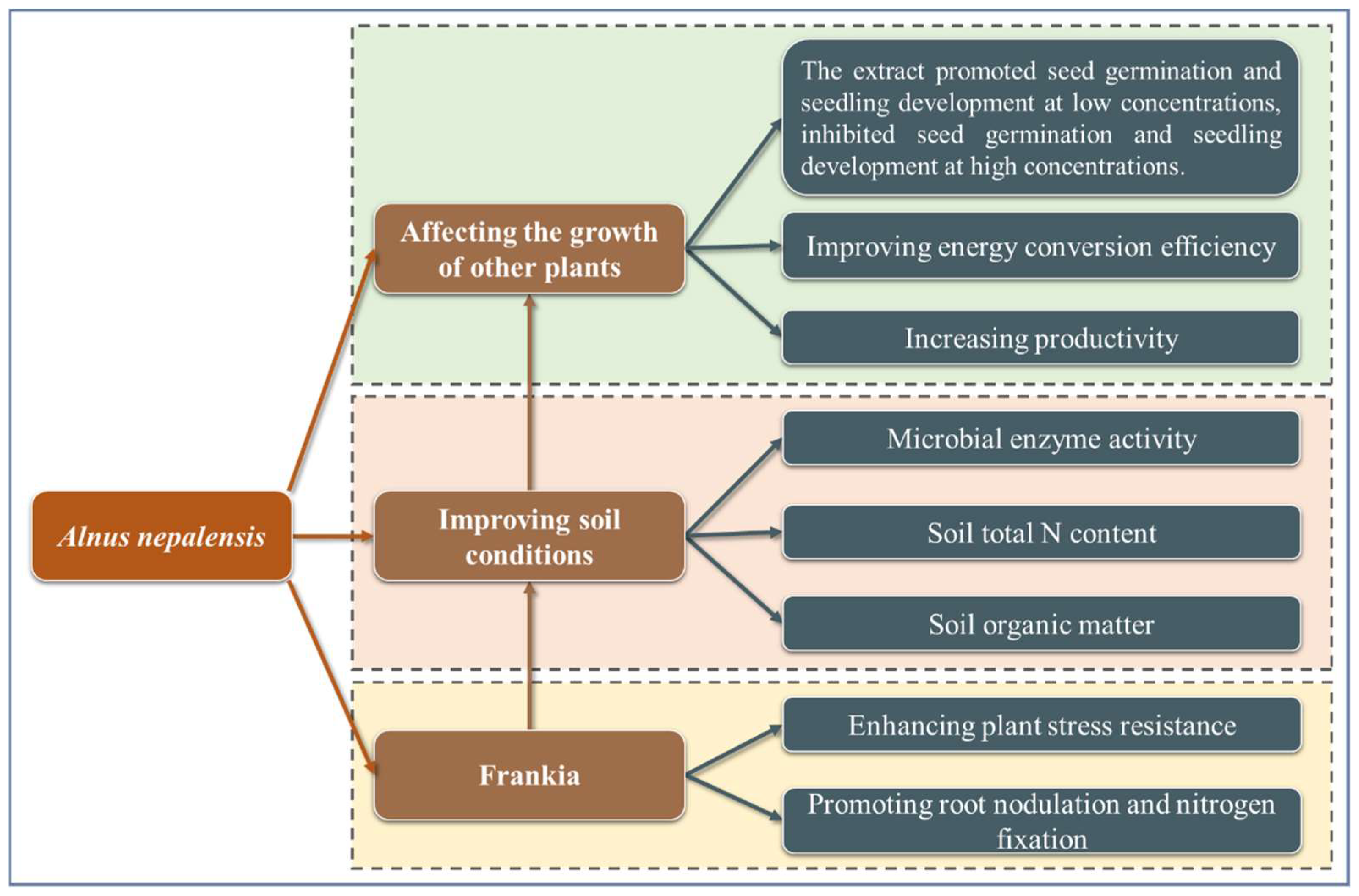
2. Development History of Nepalese Alder
The whole development history can be roughly summarized into three periods: the initial development (before 2001), the fast development (2002–2015), and the high-quality development (2016–2022) (Figure 2). Among them, the number of papers published in the early period was small, with a total of only 30 papers, and the research topics mainly focused on the growth habit and forest community structure of Nepalese alder (Figure 3a). For example, the Yunnan Institute of Forestry [19][17] reported its growth characteristics and corresponding habit, which is a relatively systematic study of Nepalese alder in China in this stage. Guo et al. (1999) found that the alder tree layer exerted a significant effect on precipitation interception in the central Yunnan plateau [20][18]. In 2002, research development entered into an accelerated period, during which the number of publications increased significantly and reached a peak in 2015 (39 articles), which was about 10 times that of 2005 (the least number of articles published in this period). This might be related to the national policy to fully launch the project of returning farmland to forest in 2002, as well as the implementation of related projects which greatly promoted the research on the fast-growing alder tree species. The focus at this stage gradually shifted to vegetation restoration and seedling growth (Figure 3b). For example, Yang et al. (2004) found that the community coverage and species composition were relatively stable in phosphate mining areas [21][19], so it had important application value in the restoration of natural vegetation in phosphate mining wasteland. Zhou et al. (2012) found that the presence of this species significantly increased the available nitrogen and potassium content in the soil, promoted the formation of soil agglomerate structure, and effectively accelerated the restoration process of vegetation in phosphate collection areas [22][20]. After 2015, the number of publications showed a downward trend, which might be related to the fact that the research has focused more on practical applications. This stage focused on soil nutrients and vegetation restoration, and related research gradually shifted to practical applications (Figure 3c); for example, the Yuanyang Rice Terraces had become a research hotspot [23,24][21][22].
Figure 2.
Changes in the number of publications of Nepalese alder since 1981.




Figure 3. Keywords network map for Nepalese alder in different development stages. (a) Initial development, (b) fast development, (c) high-quality development.
3. Growth Limiting Factors and Sustainable Utilization of Nepalese Alder
3.1. Growth Limiting Factors of Nepalese Alder
The evident northern boundary and upper limit of Nepalese alder suggested that the thermal condition should be the dominant limiting factor. Noshiro et al. studied the effects of tree height, diameter at breast height, and altitude on the anatomical characteristics of Nepalese alder wood in the eastern Himalayas and found that the pore diameter, vessel length, and fiber pipe length of wood were negatively correlated with altitude, indicating that temperature was the main factor affecting its anatomical structure [25][23]. However, further research by Noshiro et al. suggested that at altitudes above 1800 m, the vessel and fiber lengths of Nepalese alder exhibited a decreasing trend with altitude that may be related to moisture constraints [15]. Quantifying the relative contributions of different hydrothermal factors to its growth and distribution will help to understand the biogeographic distribution pattern of this species; moreover, the selection of suitable ecological sources for plantation can provide important genetic resources reserved for mountain vegetation restoration. In addition to hydrothermal factors, nitrogen and phosphorus are also important factors affecting the growth of Nepalese alder. Simulated nitrogen deposition experiments showed that the nitrogen addition at lower levels significantly promoted the growth of alder seedlings, whereas that at higher levels inhibited seedling biomass and reduced the investment to allocation of photosynthetic organs [13]. Phosphorus deficiency also decreased chlorophyll content in Nepalese alder seedlings [14]. In addition, environmental factors could indirectly influence the growth of Nepalese alder by affecting the activity or diversity of Frankia. For example, Jha et al. found that phosphate fertilizer treatment reduced mycorrhizal infection in alder seedlings, but it significantly stimulated the nodulation of alder seedlings [26][24]. It can be seen that phosphorus plays a very important role in the growth of Nepalese alder itself and Frankia, especially in humid tropical and subtropical areas where forest growth is largely affected by phosphorus restriction [27][25]. In all, the influence of climate, soil, and other factors on the growth and distribution of Nepalese alder should be comprehensively considered in the future.3.2. Physio–Ecological Characteristics and Ecological Functions of Nepalese Alder
As a pioneer species, Nepalese alder often occupies barren hillsides due to their strong adaptability, rapid growth, and strong tolerance to barren soil, and the nitrogen fixation effect of the symbiotic root with Frankia improves soil chemical status to a certain extent. Therefore, by improving the growth environment, Nepalese alder further promotes the growth and development of other plants. At present, most scholars have discussed the physiological and ecological characteristics of Nepalese alder (Figure 4). For example, some studies have explored the growth characteristics of the Nepalese alder and cardamom agroforestry system [11], and the productivity of mixed Nepalese alder and tea plants in gardens [9]. In addition, studies have also found that chemicals in Nepalese alder might affect the growth and development of other plants through allelopathy [28][26]. The study of Frankia has been a major focus of alder-related research (Figure 4). At this stage, most research has focused on genetic diversity. Studies have shown that Frankia are rich in genetic diversity, which is influenced by various factors such as climate, topography, and altitude. Through the study of the diversity of Frankia, it not only helps people to understand the origin and evolution process of Frankia, so as to build an efficient symbiotic system with strong nitrogen fixation ability and stress resistance, but also provides a scientific basis for revealing the mechanisms of the nitrogen fixation and soil improvement [29][27].
Figure 4.
A framework for physio-ecological characteristics and ecological functions of Nepalese alder.
3.2.1. Soil Improvement
The roots of Nepalese alder attached with Frankia generally form symbiosis nodulation with nitrogen fixation functions [6], thereby changing the soil physicochemical properties and increasing the soil organic matter and nitrogen and phosphorus content (Figure 4). Mishra et al. (2018) analyzed the soil fertility in different forests in the eastern Himalayas, and found that the soil organic matter content of Nepalese alder forests was significantly higher than that of other forest types, and the presence of Nepalese alder accelerated soil nutrient cycling [8]. Other studies also found that the soil total nitrogen and phosphorus, alkali-hydrolyzed nitrogen, available phosphorus, and soil microbial biomass in Nepalese alder forests were significantly higher than in other vegetation types (e.g., forests dominated by Pseudognaphalium affine, Cunninghamia lanceolata, Michelia oblonga, Parkia roxburghii, and Pinus kesiya) in the Yuanyang Terraces of Yunnan Province [30][28] and the hilly ecosystems of Northeast India [31][29]. Studies have also pointed out that Frankia in the roots of Nepalese alder can not only improve soil physical–chemical properties and increase soil-nutrient content, but also facilitate the reproduction of soil microorganisms and improve the activity of soil enzymes [9]. Li et al. further found that the presence of Nepalese alder increased the number of soil nitrogen-fixing bacteria in seven forest communities (Clerodendrum bangei, Cunninghamia lanceolata, Camellia sinensis+Alnus nepalensis, Alnus nepalensis, Gnaphalium affine, Choerospondias axillaris, and Neolitzea chui+Schima superba) in Yuanyang Terrace [32][30]. Among six different vegetation types in Yuanyang terraces, it was also found that Nepalese alder significantly increased the activity of soil proteases [30][28].3.2.2. Effect of Nepalese Alder on Other Plants
The presence of Nepalese alder can improve soil physical and chemical properties, which in turn promotes the growth of surrounding plants (Figure 4). For example, Mortimer et al. transplanted Nepalese alder to tea (Camellia sinensis var. assamica) garden, and found that the existence of Nepalese alder increased the variety and number of fungi and bacteria in the soil, which in turn improved the productivity of tea [9]. Sharma et al. found that Nepalese alder significantly increased the soil nitrogen content in the mixed agroforestry system, thereby improving the productivity and energy conversion efficiency of cardamom communities [10]. In addition, the allelopathy of Nepalese alder can also exert a positive or negative impact on the growth of other plants to some extent. Wang et al. studied the effect of fresh leaf aqueous extract of Nepalese alder on the growth of Yunnan pine seedlings and found that the lower concentration of aqueous extract (<5 g/L) can promote the growth of seedlings, enhance root vitality, and increase chlorophyll content [28][26]. However, a higher concentration above 5 g/L will inhibit the growth of seedlings. Wang et al. further treated the seeds of P. Yunnanesis with different concentrations of extracts (800, 400, 150 mg/kg) from different organs of Nepalese alder, and found that the high concentration extracts significantly inhibited the germination and seedling growth of P. yunnanensis [33][31]. Besides, this inhibition was weakened with the decrease of extract concentration, and eventually turned into a promoting effect. In summary, the effect of Nepalese alder on the growth of other plants is mainly manifested as a promoting effect, while the allelopathy on other plants is a bit more complicated. Generally speaking, a lower concentration of aqueous extract yields a promotion effect, and a higher one may lead to inhibition. That is, when the allelopathic intensity of Nepalese alder itself is high, it will have a negative impact on the growth of other plants, which may explain why Nepalese alder forms a pure forest in the juvenile stage with few other coexisting tree species.3.2.3. Frankia Infection
Frankia infection is the most representative physiological and ecological characteristic of Nepalese alder, and Frankia can form nitrogen-fixing nodules in symbiosis with Nepalese alder roots, which improves the soil conditions in the alder forest to a certain extent (Figure 4). At present, research on Frankia with Nepalese alder has focused on its genetic diversity, nutrient absorption, and morphological variation. Among them, the genetic diversity of Frankia has attracted a lot of attention. Studies have shown that the genetic diversity of Frankia nodules is influenced by a variety of factors, including topography, climate, and altitude [29][27]. On one hand, Frankia is widely distributed in multiple species, indicating that it can survive in diverse habitats [34][32]. On the other hand, in different habitats, especially at high altitudes where the environment is harsh, environmental factors such as stronger ultraviolet radiation and drought may cause genetic instability, resulting in more replication errors and higher genetic diversity to meet survival needs [35,36][33][34]. Xiong et al. studied the genetic diversity of Frankia in five regions of Yunnan, and found that the distribution and genetic structure of Frankia were closely related to the environment, and there were dominant genotypes in different regions [37][35]. Tang et al. used rep-PCR to study the genetic diversity of Frankia in Nepalese alder nodules under different habitats in Yunnan, and found the genetic diversity was positively correlated with the degree of environmental stress [29][27]. Similarly, Dai et al. [34][32] found that the genetic diversity of the Frankia strain in samples of Nepalese alder nodules in the Hengduan Mountains is related to climate and glacial history. In addition to topographical and climatic factors, altitude is also an important factor affecting the genetic diversity of Frankia, and it is assumed that the greater the altitude gradient, the richer the genetic diversity of Frankia [38,39][36][37].References
- Forestry and Grassland Bureau of Lanping County. Series of Cultivation Techniques of Main Silvicultural Tree Species in Yunnan Forest Industry (Alnus nepalensis). Available online: https://www.lanping.gov.cn/xxgk/015280551/info/2016-96381.html (accessed on 30 October 2022).
- Zhang, P.C.; Zhang, Y.P.; Yang, G.P.; Zheng, Z.; Liu, Y.H.; Tan, Z.H. Carbon storage and sequestration of tree layer in subtropical evergreen broadleaf forests in Ailao Mountain of Yunnan. Chin. J. Ecol. 2010, 29, 1047–1053.
- Zhou, G.L.; Yang, C.H. Alnus nepalensis. Guizhou For. Sci. Technol. 1988, 1, 93–95.
- Yang, C.H. Alnus nepalensis. Soil Water Conserv. China 1990, 6, 41–42.
- Wang, J.H.; Gu, W.C.; Li, B.; Guo, W.Y.; Xia, L.F. Study on selection of Alnus cremastogyne provenance/ family—Analysis of growth adaptation and genetic atability. Sci. Silvae Sin. 2000, 36, 59–66.
- Varghese, R.; Chauhan, V.S.; Misra, A.K. Evolutionary implications of nucleotide sequence relatedness between Alnus nepalensis and Alnus glutinosa and also between corresponding Frankia micro symbionts. Plant Soil 2003, 254, 219–227.
- Chaudhry, S.; Singh, S.P.; Singh, J.S. Performance of Seedlings of Various Life Forms on Landslide-Damaged Forest Sites in Central Himalaya. J. Appl. Ecol. 1996, 33, 109–117.
- Mishra, G.; Giri, K.; Pandey, S. Role of Alnus nepalensis in Restoring Soil Fertility: A Case Study in Mokokchung, Nagaland. Natl. Acad. Sci. Lett. 2018, 41, 265–268.
- Mortimer, P.E.; Gui, H.; Xu, J.; Zhang, C.; Barrios, E.; Hyde, K.D. Alder trees enhance crop productivity and soil microbial biomass in tea plantations. Appl. Soil Ecol. 2015, 96, 25–32.
- Sharma, G.; Sharma, R.; Sharma, E.; Singh, K.K. Performance of an age series of Alnus-cardamom plantations in the Sikkim Himalaya: Nutrient dynamics. Ann. Bot. 2002, 89, 273–282.
- Sharma, G.; Sharma, E.; Sharma, R.; Singh, K.K. Performance of an age series of alnus-cardamom plantations in the Sikkim Himalaya: Productivity, energetics and efficiencies. Ann Bot. 2002, 89, 261–272.
- Li, S.Y.; Guan, X.Y.; Chang, N.N.; Wang, Q.H.; Shu, L.F. Comparative study on combustion characteristics of different size live ranches of Alnus nepalensis. J. Cent. South Univ. For. Technol. 2011, 31, 61–64.
- Tang, H.Y.; Xu, L.P.; Li, S.F.; Huang, X.B.; Yang, L.H. Effects of simulated nitrogen deposition on the growth, twig and leaf traits of Alnus nepalensis seedlings in the southern subtropical region. J. Northwest For. Univ. 2018, 33, 162–166.
- Liu, Z.N. Effects of nitrogen and phosphorus stress on physiological indexes response and changes of mixed planting seedlings of pinus yunnanensis and Alnus nepalensis. For. Inventory Plan. 2019, 44, 225–230.
- Noshiro, S.; Suzuki, M.; Joshi, L.; Ikeda, H.; Ohba, H. Ecological wood anatomy of Alnus nepalensis (Betulaceae) throughout Nepal. Iawa J. 2020, 41, 261–277.
- Sharma, G.; Sharma, R.; Sharma, E. Impact of altitudinal gradients on energetics and efficiencies of N2 -fixation in alder–cardamom agroforestry systems of the eastern Himalayas. Ecol. Res. 2010, 25, 1–12.
- Yunnan Institute of Forestry Science. Alnus nepalensis. J. West China For. Sci. 1975, 18–19. Available online: https://www.oriprobe.com/journals/caod_2440.html (accessed on 30 October 2022).
- Guo, L.Q.; Wang, Q.H.; Zhou, H.C.; Yang, W. Rainfall interception of forest plants of main forest types in central Yunnan plateau. Yunnan For. Sci. Tech. 1999, 1, 13–22.
- Yang, L.P.; Ye, Q.Y.; Yang, S.H.; Wang, B.R. The features of Alnus nepalensis community in phosphate mining wasteland and its role in vegetation restoration. J. Yunnan Univ. 2004, 26, 234–237.
- Zhou, Q.H.; Duan, X.M.; Yue, F. Effects of Alnus nepalensis plantation on soil physical and chemical properties in the cutting area of Kunming phosphate mine. Jiangsu Agric. Sci. 2012, 40, 324–325.
- Li, M.P.; Liao, N.; Liu, S.R. Effect of nitrogen-fixing tree species Alnus nepalensis on the degraded soils and understory restoration in the upper reaches of the Jinsha River, China. Acta Ecol. Sin. 2022, 42, 2321–2330.
- Zhao, C.; He, L.P.; Li, G.X.; Shao, J.P.; Chai, Y. Impacts of vegetation restoration on the soil organic carbon storage in Kunyang phosphorite mine. Res. Soil Water Conserv. 2017, 24, 168–171.
- Noshiro, S.; Joshi, L.; Suzuki, M. Ecological wood anatomy of Alnus nepalensis (Betulaceae) in East Nepal. J. Plant Res. 1994, 107, 399–408.
- Jha, D.K.; Sharma, G.D.; Mishra, R.R. Mineral nutrition in the tripartite interaction between Frankia, Glomus and Alnus at different soil phosphorus regimes. New Phytol. 1993, 123, 307–311.
- Hou, E.Q.; Luo, Y.Q.; Kuang, Y.W.; Chen, C.R.; Liu, X.K.; Jiang, L.F.; Luo, X.Z.; Wen, D.Z. Global meta-analysis shows pervasive phosphorus limitation of aboveground plant production in natural terrestrial ecosystems. Nat. Commun. 2020, 11, 637.
- Wang, X.L.; Cao, Z.L.; Zhu, X. Allelopathy of water extract of Alnus nepalensis on the seedling growth of Pinus yunnanensis. J. Gansu Agric. Univ. 2012, 47, 76–79.
- Tang, X.M.; Dai, Y.M.; Xiong, Z.; Zhang, Z.Z.; Zhang, C.G. Effect of nature stress on genetic diversity of Frankia in Alnus nodules. Chin. J. Appl. Ecol. 2003, 14, 1743–1746.
- Wu, L.T.; Zhang, Z.H.; Xie, G.L.; Di, X.Y.; Shi, H. Contents of soil nutrients and characteristics of enzyme activities in different vegetation types of the Yuanyang terraces. Guangdong Agric. Sci. 2022, 49, 86–95.
- Ramesh, T.; Manjaiah, K.M.; Tomar, J.M.S.; Ngachan, S.V. Effect of multipurpose tree species on soil fertility and CO2 efflux under hilly ecosystems of Northeast India. Agrofor. Syst. 2013, 87, 1377–1388.
- Li, M.R.; Li, T.G.; Li, B.; Qin, L.; Jiang, M. Soil microorganisms quantities and nutrients contents of different forest communication at core zone on Yuanyang terrace. J. West China For. Sci. 2019, 48, 49–55.
- Wang, X.L.; Cao, Z.L.; Zhu, X. Allelopathic effect of ether ethano extraction from Alnus nepalensis organs on pinus yunnanensis seed germination. J. Southwest For. Univ. 2010, 30, 21–23.
- Dai, Y.M.; He, X.Y.; Zhang, C.G.; Zhang, Z.Z. Characterization of genetic diversity of Frankia strains in nodules of Alnus nepalensis (D. Don) from the Hengduan Mountains on the basis of PCR-RFLP analysis of thenif D-nif KIGS. Plant Soil 2004, 267, 207–212.
- Cai, M.J.; Feng, H.Y.; An, L.Z.; Wang, X.L. Present status and prospects in research on effect of enhanced UV-B radiation on plants. Chin. J. Appl. Ecol. 2002, 13, 359–364.
- Nevo, E. Evolution of genome–phenome diversity under environmental stress. Proc. Natl. Acad. Sci. USA 2001, 98, 6233–6240.
- Xiong, Z.; Tang, X.M.; Dai, Y.M.; Zhang, C.G.; Zhang, Z.Z.; Xu, L.H. Genetic diversity of Frankia strains in Alnus nepalensis nodules in Yunnan revealed by rep-PCR. Chin. J. Appl. Environ. 2006, 12, 623–627.
- Khan, A.; Myrold, D.D.; Misa, A.K. Distribution of Frankia genotypes occupying Alnus nepalensis nodules with respect to altitude and soil characteristics in the Sikkim Himalayas. Physiol. Plant. 2007, 130, 364–371.
- Xiong, Z.; Li, W.J.; Zhang, Z.Z.; Jiang, C.L. The influence of altitude on the genetic diversity of microsymbionts of Alnus nepalensis—Frankia. J. Southwest For. Univ. 2001, 21, 205–209.
More
